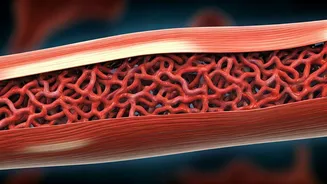Protein Absorption Explained
The notion of a rigid protein absorption limit has long been a topic of debate. The popular belief suggests that the body can only assimilate around 20-30
grams of protein in a single sitting, with any excess simply being wasted. However, recent scientific findings challenge this viewpoint. Research reveals that the human body is more adaptable than once thought, capable of utilizing larger protein portions, especially when distributed across the day. The rate at which protein is absorbed and utilized depends on multiple individual factors, including body composition, activity levels, the overall protein intake, and the food source’s quality. Furthermore, the body continually utilizes amino acids from the proteins consumed, not merely at a singular point in time.
Factors Affecting Utilization
The efficiency with which the body processes protein isn't solely determined by the amount consumed in one go. Factors such as the protein source significantly affect the digestion and absorption rates. For instance, whey protein, a common supplement, is known for its quick absorption, whereas casein protein is digested much more slowly. Moreover, the digestibility of protein from plant sources can differ due to the presence of fiber and antinutrients. Besides the source, the overall activity level influences the body's need for protein. Individuals who are physically active, particularly those engaged in strength training, have increased protein requirements to support muscle repair and growth. Furthermore, the body's existing muscle mass also plays a significant role; a person with more muscle generally utilizes protein more effectively than someone with less.
Optimizing Protein Intake
For optimizing protein intake, it is important to consider the timing and distribution of protein consumption throughout the day. Instead of focusing on single, large protein servings, consider distributing protein intake across multiple meals and snacks to maintain a steady amino acid supply for the muscles. This approach helps in maximizing muscle protein synthesis, the process by which the body builds and repairs muscle tissue. For individuals aiming to build muscle mass, a general guideline is to consume approximately 1.6 to 2.2 grams of protein per kilogram of body weight each day. This amount should be spread throughout the day to maximize protein synthesis. Furthermore, pairing protein with carbohydrates and healthy fats can help facilitate protein absorption and increase the body's utilization of the amino acids present.
Myth-Busting: Protein Waste
The widespread concern about the body “wasting” excess protein is often overstated. While the body can't store protein in the same manner as it stores carbohydrates or fats, any protein the body does not use for protein synthesis gets used for other processes. Excess protein is typically not “wasted” but rather used for energy or, if consumed in large quantities, may get converted and stored as fat. This process is less efficient than the body using carbohydrates or fats as energy. The kidneys and liver also play a role in processing protein, and excessive intake can potentially strain these organs, particularly in individuals with pre-existing conditions. Therefore, while the body can handle more protein than previously believed, it is crucial to consider individual needs, activity levels, and overall health when deciding on protein intake.










